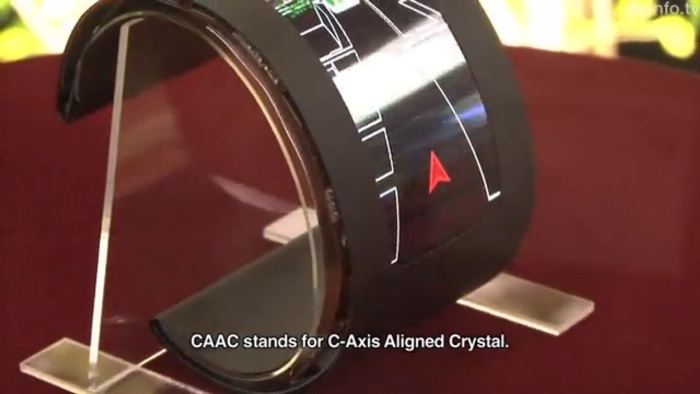Foldable Displays Now Close to Becoming Commercially Available
![By Bin im Garten (Own work (own picture)) [CC-BY-SA-3.0 (http://creativecommons.org/licenses/by-sa/3.0)], via Wikimedia Commons](https://techtheday.com/wp-content/uploads/2014/11/Flexible-display.jpg)
By Bin im Garten (Own work (own picture)) [CC-BY-SA-3.0 (http://creativecommons.org/licenses/by-sa/3.0)], via Wikimedia Commons
Around a year ago, after the so called Youm display was officially announced, Samsung released a video showcasing the company’s ideas in the area of flexible and foldable displays. At that time, the Korean manufacturer didn’t have any actual foldable display to demonstrate. Samsung had a flexible display but it did not have the more practical foldable display yet. This year, real foldable displays appear to be close to becoming commercially available.
Nokia’s Foldable Display
Last June, even after Microsoft finalized the acquisition of almost the entire existence of the famous Finnish mobile phone maker, Nokia managed to impress the world by demoing its folding display technology in San Diego, at the Society for Information Display 2014 conference.
There were two types of this foldable display showcased. The first was dubbed by Nokia as a “book type” display. Just like a traditional book, it folds in the middle. It is a 5.9-inch panel (unfolded) and has a 1280×720 or HD resolution, making for a pixel density of 249ppi. The second display is a “three-fold” type, having two folding points to fold the display into a more compact size.
Both displays can be folded to a 2mm radius. This means that the folded panels don’t get to touch each other but are very close enough to escape the mere “curve” or “flexible” categorization. Repeated folding will eventually damage the foldable panels but not after the 100,000th fold.
To achieve this foldability, these Nokia panels are created by forming release, sealing, color filter, TFT, and OLED layers on a glass substrate then peeling off the glass substrate to be replaced with a flexible substrate.
So far, this display from Nokia is still not yet available and the company did not mention any timeline for the possible market release or on how it will be used on a device.
Semiconductor Energy Laboratory’s Foldable Display
A more recent attempt at foldable display technology comes from Japanese company Semiconductor Energy Laboratory. This time, the foldable display is being touted as “super-strong” but flexible. The display was demonstrated at a Tokyo exhibition this November.

Screenshot of DigInfo TV’s report on Semiconductor Energy Laboratory’s foldable OLED display posted on YouTube.
Interestingly, this new foldable display has a number of striking similarities with Nokia’s foldable display tech. For one, the panel size is the same 5.9 inches. The display is also of the OLED type. Since it’s intended for mobile devices that primarily designed to work through touch controls, it also comes with touch sensors. Just like the foldable Nokia displays, this Japanese-made display is also stated to be able to withstand 100,000 instances of bending, or more.
During the demo, the display showed images of landscapes, peacocks, and cats while getting flexed and bent. Additionally, it demonstrated capabilities comparable to Samsung’s flexible display tech like the one used on the Galaxy Note Edge. These include the ability to show notification on the edges and display notifications while a video is playing on the main (unfolded) screen.
The material used to make this display from Semiconductor Energy Laboratory highly flexible but durable is referred to as a high molecular substance-based polyimide film. It enables the display to bend to a maximum curvature radius of 2mm or 0.7 inch, similar to what can be achieved by the foldable displays of Nokia. Polyimide is used because it helps reduce the thickness of the overall display panel while improving flexibility.
Better than Curved or Flexible Display
Flexible displays are definitely an advancement in display technology. However, being merely flexible does not have many practical uses. They might took great on smart watches but they are not that practically useful on smartphones, tablets, and even on televisions. There’s a reason why curved HDTVs are not considered a major leap in television technology.
Samsung’s Galaxy Round and LG’s Flex handsets both feature flexible displays and they all failed to become commercially successful. Likewise, device reviewers don’t have praises for them. Even the relatively recently released Galaxy Note Edge, with its overarching flexible display, is not getting praises from most reviewers. The idea of putting flexible displays on devices is a novelty that easily wears off because it does not really deliver any practical use, does not enhance the user experience. They’re just like having the more expensive sapphire displays on iPhones instead of using the traditional tempered glass. The idea makes for an attractive press release but does not offer anything significantly advantageous to end users.
![By http://www.flickr.com/people/pestoverde/ [CC-BY-2.0 (http://creativecommons.org/licenses/by/2.0)], via Wikimedia Commons](https://techtheday.com/wp-content/uploads/2014/11/Samsung-Galaxy-Note-Edge.jpg)
By http://www.flickr.com/people/pestoverde/ [CC-BY-2.0 (http://creativecommons.org/licenses/by/2.0)], via Wikimedia Commons
Foldable displays are better than flexible or curved ones because they can make a device’s size more compact. Just imagine a smartphone or tablet with “flip” or clamshell form factor that opens into an impressive media viewing device with a wide 2.39:1 aspect ratio or greater. It can address pocketability issues and can serve as a good way to protect the display from scratches.